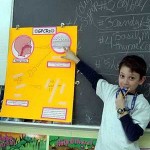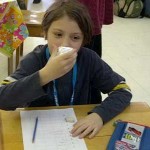GPCRs
October 6, 2011 in Protein
Dear MLP enthusiasts,
On Monday, April 7th, 2008, the students in Mrs Shuster’s third grade class at École F.A.C.E. School gained a better appreciation of their sense of smell as university students Catherine-Emmanuelle Drapeau (BFA Art Education, Concordia U.) and Tarek Kassem (Ph.D., U. Montpellier ’00) presented “G-protein coupled receptors” (GPCRs) in our seventh Molecules of Life Project (MLP) in Montreal.
Catherine and Tarek distributed ten samples of boxes with hidden contents of various odorous foods and flavors, of which the students were asked to smell and thereby decide what was inside.
Comparing their lists with each other and with the revealed unknown food, the students recognized how similar and varied their sense of smells could be contingent on what odor they smelt.
Using an interactive poster, Tarek took the students on a trip into the nose. With magnified views, the students first recognized the nasal cavity and the tissues of the nasal membranes, They then then peered into the cells of the nasal tissues and arrived eventually at the G-protein coupled receptors (GPCRs) in the cellular membranes. Tarek described that when the GPCRs come in contact with an odor molecule, it binds to the loops of these proteins at the outside of the cell. Then, the GPCR’s seven helices inside the membrane begin to move (to “shake”) in a way that releases, from a loop inside the cell, a G-protein, that sends a signal to tell the cell that an odor molecule has been recognized.
Catherine described how the students could build their own models of GPCRs, for hanging in the classroom as mobiles.
First, showing pictures of mobiles designed by their originator Alexander Calder, Catherine explained to the students to sculpt helices and loops from pipe-cleaners and thread them through two styrofoam trays that represent the inner and outer walls of the cell membrane. Exploring protein folding in this fun way, the students placed finally a paper circle, with “G” written on one side and the student’s favorite odorous foods on the other side, onto the tail of their serpentine receptor models, to represent their associated G-protein.
With their GPCR models in hand, we reviewed how molecules bind to the loops outside of the cell, how such binding causes the helices to move inside the membrane and how such movement causes release of the G-protein to send to the inside of the cell a message, that something smells good outside.
For more information on GPCRs see:
http://en.wikipedia.org/wiki/G_protein-coupled_receptor
For signaling via G-protein-Coupled Receptors
www.web-books.com/MoBio/Free/Ch6D.htm
For an image of GPCRs and their importance as drug receptors see:
www.molres.org/jlameh/jlameh_gpcr.html
For more on Calder Mobiles see:
www.sfmoma.org/espace/calder/calder_windmobiles.html
www.guggenheimcollection.org/site/artist_work_md_26_2.html
Or our ‘Resource for Teachers’ poster : http://moleculesoflife.ca/2012/05/teach-about-g-protein-coupled-receptors-gpcrs/

















